






Paracas National Reserve
The National Reserve of Paracas was created on September 25, 1975 through Law (D.S.) N 1281-75-AG. This is the only protected natural area in Peru with different ecosystems. In 1991 was declared Regional Reserve for migratories birds by the hemispheric net work of birds (Today the program is called: “Wetlands for the Americas”). Likewise, on April 1992 was incorporated to the convention Ramsar.
This reserve is located in the department of Ica, province of Pisco, district of Paracas and has a surface of 335,000 hectares, but 217,594 belong to the sea. This reserve crounts on a very rich diversity of birds which are residents, migratories and endemics. These birds are: 1) the playero blanco (Calidris mauri), the playero semipalmado (Calidris pusilla), the charlo (Charadius semipalmatus), the flamingo (Phoenicopterus chilensis), among others.
We can also find sea birds such as: the peruvian piquero (Sula vanegata) the guanay (Phala crocorax bougainvillii), the pelican (Pelecanus thagus), the peruvian seagull (Sterna lorata) which feed from small fiches living in the surface of the sea. The San Gallan and La Vieja Islands are the only places for the potoyunco (Pelecanoides garnottii) to reproduce in Peru.
The popular penguin of Humboldt (Spheniscus Humboldt) and the potoyunco are in danger of extinction. We con also observe the condor (Voltur gryphus). Among the most impressive mammals living in the area it is necessary to mention the several species of seals, for example the mongler seal (Otarya bironia) and the fine seal (Arctoc phalus australis) as well as the sea cat or chigungo (Lutra felino) which is in danger of extinction.
We can also observe the coastal wolf (Pseudalopex sechurae), that sometimes you can see it walking through the desert next to the beach, bats are found in the coast too. With regard to reptiles we find lizards (Microlophus peruvianus) . Some sea turtles live ion the waters of the area basically during El Niño, among the turtles living there are the green turtle (Chelonia agassizzii) and the small sea turtle (Lepidochelys Olivacea). Likewise the are general ecosystems like in Cerro Lechuza, Morro Quemado and San Gallán, in the sea there are seaweeds like viva fasciata and viva papenfusii.
**Prices may vary depending on travel dates. For more information, fill in the form to get in contact with a Travel Advisor.
Prices from USD based on double occupancy.





















Address:
Av. Camino Real N° 111 Office 205 Second Floor San Isidro, Lima - Perú
Av. Primavera 543 4to.piso Chacarilla del Estanque - San Borja
Phone:
E-mail:
Copyright © 2023 by Perutravels.net